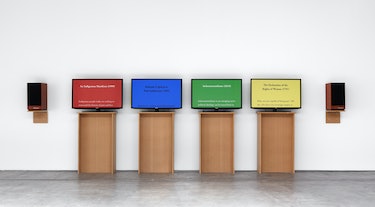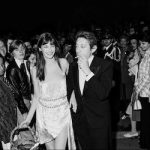Nestled into the industrial hub of Huntington Park, inside a former tile factory just south of Downtown Los Angeles, the 11,000-square-foot studio of Charles Gaines is a minimalist temple to his 50-year conceptual art practice. Through a serene Mediterranean garden planted with olive trees, visitors enter into a skylighted “great hall” where a half dozen AirPodded assistants work in library silence. They are meticulously numbering and painting blue, green, orange, and pink squares atop gridded Plexiglas boxes.
These are the latest works in Gaines’s ongoing “Numbers and Trees” series, which embraces one of the enduring tropes of his five-decade career. Like a mash-up of pointillism and paint-by-numbers, these pixelated formations look like a Tetris game up close. But as one walks away, contemplating them from a distance, they begin to resemble the leafy Arizona cottonwoods depicted in the photos that are mounted beneath the grids.
There’s a Rorschach effect to these pieces, which are made according to rules-based systems. Gaines begins with an image—in this case, a photograph of a tree—and plots its outline to a dense grid. He arbitrarily assigns colors to the tree, and then his assistants paint and number the grids according to his systems. Gaines usually works in series of eight to 18, layering each finished grid with a new tree and additional colors, so the images become denser and richer. The final work, which consolidates all the grids into one unified piece, often creates what Gaines calls “a sublime response” in viewers. “My interest in doing this is to show the role that structures play in how things acquire meaning,” says Gaines. “I am making a point that art is not based upon your subjectivity.”
Dressed in a black athletic shirt, blue khakis, and black sneakers—the uniform of a man who, at 79, still plays tennis and goes to the studio almost every day of the week—Gaines speaks in the measured tones of the semiotics and art history professor that he once was: He spent three decades at CalArts mentoring a who’s who of the contemporary L.A. art world, including Mark Bradford, Laura Owens, Henry Taylor, and Lauren Halsey. But he also loves to puncture serious exchanges with a booming, gravelly laugh.
An installation schematic for Submerged Text.
Fredrik Nilsen.
Numbers and Trees: Palm Canyon, Palm Trees Series 2, Tree #5, Quechan, 2019.
© Charles Gaines, courtesy of the artist and Hauser & Wirth.
Gaines has had peaks and valleys in his long career, but since joining the roster of Hauser & Wirth, in 2018, he’s had solo shows at the gallery’s New York, Southampton, Saint Moritz, Los Angeles, and London branches. He recently completed the second segment of a three-part, two-city, decade-in-the-making magnum opus, The American Manifest, which featured a rapturous musical performance in New York’s Times Square and a 110-foot-long shiplike sculpture with nine 1,600-pound chains moving overhead that was displayed on nearby Governors Island. This epic meditation on the slave economy will travel to the banks of the Ohio River, just a short walk from Cincinnati’s National Underground Railroad Freedom Center, next summer. Gaines has also recently been honored with ambitious museum surveys at Dia Beacon and SFMOMA.
“If I was his age, I’d be slowing my operation down,” says his son, Malik Gaines, a writer and performance artist with the My Barbarian theatrical collective. “He just loves working. I’m sure he’s extremely gratified with this current situation, to now have the resources to execute his projects at this scale.”
Rolled templates in the studio.
Fredrik Nilsen.
Next up is a sprawling show at the ICA Miami, “Charles Gaines: 1992–2023,” which runs through March before traveling in the fall to the Phoenix Art Museum. ICA Miami curator Gean Moreno felt that 1992 should be the starting point for the exhibition because that’s when, he argues, Gaines started working with “very charged materials.” Moreno is referring to series like “Night/Crimes,” which paired mug shots of criminals and murder crime scene photos with images of the night sky, and the “Manifestos” works, which reinterpreted political texts—many about systemic racism, by Malcolm X, Martin Luther King Jr., and Frantz Fanon—as musical performances. “I don’t know what the results are going to be,” Gaines says of the works in the ICA Miami show. “I just hope that they contribute to a certain understanding about the nature of meaning in the world.”
One could say Gaines seemed destined to find counterintuitive ways of addressing racial injustice. Born in the Jim Crow South to a dressmaker mother and a construction worker father (who labored for half the wages of his white contemporaries), he lived with his family in a small wooden house on a dirt road with chickens and pigs roaming outside. They joined the Great Migration, moving from Charleston, South Carolina, to Newark, New Jersey, when he was 5. While racial tensions were high in Charleston, “Newark wasn’t that much better,” says Gaines.
A self-described “late bloomer,” Gaines was a C student but a good draftsman, and earned a spot at Newark Arts High School, where music stars like Sarah Vaughn and Wayne Shorter and actor Michael B. Jordan all got their start. “I wasn’t in the music program, but I got to know the jazz people,” recalls Gaines. “So I decided I wanted to play drums.” He gigged around R&B clubs in Newark, including one owned by James Brown, and eventually earned an MFA at New York’s Rochester Institute of Technology. He then got a job teaching studio art and art history at the predominantly Black Mississippi Valley State College. But when the governor sent in state police to quell student marches after the assassination of Martin Luther King Jr., in 1968, Gaines resigned because, he says, “I learned spies were being planted in the classrooms.”
A view of the main studio.
Fredrik Nilsen.
He moved west, landing at California State University, Fresno, where he launched his theory-based class, “Content and Form,” which he would later teach all through his CalArts tenure. Students literally “lined up,” according to Thomas Lawson, former dean of the Art School at CalArts, to attend Gaines’s rigorous lectures with readings from Foucault to Focillon, whose essays informed the class title.
“I didn’t have the language, but he worked with me at my own pace, literally breaking down sentences,” says the artist Lauren Halsey, whom Gaines mentored and later employed before she went to graduate school at Yale. “It was the most formative experience to have my first encounter with a professional studio be with this beautiful, genius Black guy who affirmed me in my day-to-day.”
Race is by no means the only important topic that Gaines addresses in his practice. One rarely seen piece that will be on view in Miami is his interactive sculptural installation Greenhouse, a large glass enclosure that was hooked to pollution sensors around Los Angeles for a 2007 exhibition at LAXART. Increases in the pollution levels, and the types of pollution, could be seen on an LED display, triggering colored lights to illuminate the cube when a fog machine blew into it. The Miami version of Greenhouse will have two monitors, one displaying global temperature changes from the 18th century to the present, the other depicting current temperatures around the globe.
The paint swatches Gaines uses to map out his densely gridded works.
© Charles Gaines, courtesy of the artist and Hauser & Wirth.
While the scale of Greenhouse might have been inconceivable to Gaines half a century ago, the seeds of such ambitious work were always there. Like John Baldessari, his predecessor on the faculty at CalArts, Gaines began his career as a figurative and abstract painter before making a hard pivot to conceptual art. His early abstractions, which he created by repeating linear gestures on a canvas with an antiquing tool, launched his career and earned him a spot in the 1975 Whitney Biennial. But even then, Gaines had already made his first forays into systems-based work with his “Regression” series, influenced by the mandalas and grids in Tantric Buddhist art. “Those Tantric drawings were not just empirical objects—they came out of meditations,” says Gaines of his early works, which mapped geometric forms using his repeating grid system. “The shapes resembled what happens in cell reproduction,” explains Gaines.
At around that time, on a drive around the San Joaquin Valley, he happened upon a revelation: an orchard of walnut trees. If he used his grid system, Gaines believed, “the trees could paint themselves.” The resulting “Walnut Tree Orchard” triptychs each featured a photo of a single tree snapped on his medium-format camera—overlayed by a no-frills line drawing of that same tree. As more and more grids were added, the composites would overlap in a complex matrix of colors. And if the trees could “paint themselves” with his systems, thought Gaines, why couldn’t the systems combine the facial features of a variety of people (Faces, 1978–1979), or trace the penumbras of house plants basking in sunlight (Shadows, 1980), or map the motions of one of the founders of Judson Dance Theater, Trisha Brown (Motion: Trisha Brown Dance, 1980–1981)?
Those early grids reached a broader audience with help from conceptual art icon Sol LeWitt, who shared Gaines’s work with such dealers as Leo Castelli. By the 1980s, Gaines would have simultaneous representation by not one but two blue-chip New York dealers—Castelli and John Weber—and the L.A. powerhouse Margo Leavin. However, becoming one of the first African Americans (if not the first) in the field of conceptual art—a phrase often repeated about Gaines—didn’t exactly endear him to the Black Arts Movement. “They told me I was making white art and that I should be making art about my culture,” says Gaines. This period ended with him joining CalArts, in 1989, followed by a fallow stretch on the gallery front when, Gaines has said, “I couldn’t give that work away.”
String Theory: Rewriting Fanon #6 (Pg 156) “Black Skin White Masks,” 2010.
© Charles Gaines, courtesy of the artist and Hauser & Wirth.
Gaines outside his studio, in Los Angeles.
“For many years, he was most associated with teaching, and former students like Mark Bradford, Rodney McMillian, Andrea Bowers, and Sam Durant were all telling people about Charles,” says Malik Gaines. “But he is also someone for whom conceptualism is not just a set of systems, it’s a belief in ideas—and he really works on an idea and sees it through in a way that is unflappable.”
Something Gaines was grappling with in the 1990s was the history of criticism that marginalized Black artists. His research led to a landmark 1993 group show, “The Theater of Refusal: Black Art and Mainstream Criticism,” which he curated at UC Irvine, installing works by Gary Simmons, David Hammons, Adrian Piper, and Jean-Michel Basquiat against the offending criticism aimed at those artists.
Though Gaines retired from CalArts last year, he’s not done mentoring new talent. There is a new MFA fellowship in his name that provides full tuition for two students each year. “I didn’t really have any mentors, and I feel I was cheated,” says Gaines. He makes it clear that he doesn’t think of the fellowship in terms of his own legacy. “We’ve simply been trying to get support for artists of color since 1989 and never succeeded, because not everybody thought it was a good idea,” he says. “Now I finally got to the point where I could do it myself.”
Grooming by Sara Denman for Charlotte Tilbury at Celestine Agency; photo assistants: Blake Jacobson, Alex Slade.



